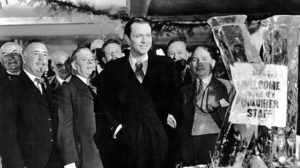 The Film Snob explains why Orson Welles’ technique in Citizen Kane was so innovative.
The Film Snob explains why Orson Welles’ technique in Citizen Kane was so innovative.
When you put something on a pedestal, it becomes a prime target for pigeons. Or to put it another way – if a certain movie consistently shows up on those “Ten Best of All Time” lists, and often as the “Greatest Film of All Time,” – you can be sure of a backlash. I’m talking about Citizen Kane, directed by Orson Welles. The movie that was booed at the Oscars in 1942 had its reputation restored by film critics in the 50s and eventually became a sacred cow. Now I actually hear some people call it “overrated.” Well, my intention is not to keep it on a pedestal, but I do believe it deserves a reputation not only as a great and important film, but as a moving and entertaining one as well.
This topic is too big to cover in one show, so for now I’ll just talk about technique. That’s the first thing you usually hear about this movie: deep focus photography, low angle shots and wide angle lenses, the use of ceilings, overlapping dialogue, sudden cuts, and so forth. But what isn’t often mentioned is the context—that is, what kind of film audiences in America were accustomed to in 1941.
Studio technique developed through trial and error until it was perfected in a form now dubbed the “seamless” American style. “Seamless” because you’re not supposed to notice the style at all—technique was to be unobtrusive, serving, with clarity and restraint, as a vehicle for the story. Establishing shot, medium shot, close-up, medium shot again. The camera movement is restricted to what is necessary in order to follow the plot. The very position of a speaker’s head relative to the back of the head of the person he’s talking to was part of a visual grammar so commonplace that it was instantly understood by an audience. This was the smooth structure of narrative film, and it is still followed by most directors today. In order to understand why Citizen Kane is so bold, it is necessary to be used to this Hollywood style, to recognize one’s own comfort with it, one’s assumption that this is the way to tell a story on film. Then, when you watch Citizen Kane, you can feel the full force of its difference, and it’s like opening your eyes to completely new depths and perspectives.
Orson Welles took a visual style and flaunted it—the viewer is reminded that he or she is watching a movie—and it is just this that is exhilarating about watching it. For example: after the sequence when we see Kane’s mother signing her son away to the banker Walter Thatcher (perhaps the most haunting and ambiguous section of the film), there is a shot of the abandoned sled gradually being buried in the falling snow. Suddenly we cut to a gift being opened—it’s a new sled. Thatcher is looking down and saying “Merry Christmas, Charles.” Young Kane looks up and says, in a defiant and sarcastic tone of voice: “Merry Christmas!” Suddenly we cut to an older Thatcher saying “…and a Happy New Year.” It is years later and he is dictating a letter to the absent Kane, who is now 25 years old.
The textbooks will tell you that Welles has compressed fifteen years into a few seconds using the most daring economy. This is true. The Hollywood film was in the habit of flipping the pages of calendars to indicate the passage of time, or showing clocks or hourglasses, to the point where it had become a cliché. The lightning cuts are much more creative. But besides this, the sequence has power in its intent to startle the viewer with technique. The sled evokes sadness and loss, the shot of the boy saying “Merry Christmas” evokes his powerlessness, hatred and rebellion. And the quick cut fifteen years ahead forces the viewer to quickly adjust to the passage of time, while also drawing attention to the very audacity of the film’s own craft. In other words, the viewer gets to be engaged in the story and at the same time gets to enjoy the flamboyance of the way the story is being told. This double layer of enjoyment makes the experience of Citizen Kane a liberating one, a leap forward from the conventional method.
 Another example: when Kane, Leland, and Bernstein are looking at the group photograph of the reporters in the window of the rival newspaper The Chronicle, the camera moves closer to the photo, then we hear Kane’s voice saying that six years ago he was looking at this picture. Suddenly he walks across the screen. The photo has become reality: Kane has bought The Chronicle’s reporters for The Inquirer, and there they sit, six years later, having their picture taken at a celebration. This sequence employs a similar compression of time, and combines it with a visual trick which is amusing in its theatricality. The audience laughs not only at the fact that Kane has bought out the competition, but at the technique itself, the audio and visual switcheroo with which Welles makes his point.
Another example: when Kane, Leland, and Bernstein are looking at the group photograph of the reporters in the window of the rival newspaper The Chronicle, the camera moves closer to the photo, then we hear Kane’s voice saying that six years ago he was looking at this picture. Suddenly he walks across the screen. The photo has become reality: Kane has bought The Chronicle’s reporters for The Inquirer, and there they sit, six years later, having their picture taken at a celebration. This sequence employs a similar compression of time, and combines it with a visual trick which is amusing in its theatricality. The audience laughs not only at the fact that Kane has bought out the competition, but at the technique itself, the audio and visual switcheroo with which Welles makes his point.
At some later date I’d like to talk about the story itself and its meanings, but for now I hope that I’ve helped anyone intimidated by Citizen Kane’s classic status, to watch it, or watch it again, with fresh eyes.

